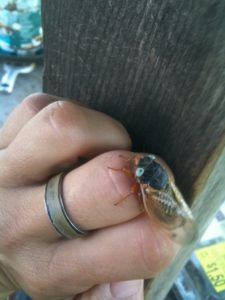Brood XIX emergence update
Looking at the Cicadas @ UCONN emergence map it appears that the cicadas have emerged everywhere they’re expected to emerge.
The next question is, when will they be gone? Local emergences typically last between four to six weeks, starting from the first emerging nymph, to the last dead cicada. I wouldn’t expect any cicadas around today to be around on Independence Day. Their corpses will be around though – so don’t forget to rake them up.
White Eyed Cicada Contest
The White Eyed Cicada Contest is over and 10 people won I Love Cicada pins. Congratulations to Joey Simmons of Nashville, TN, Meagan Lang of Nashville, TN, Serena Cochrane of Gerald MO, Melissa Han of Nashville TN, Jane and Evan Skinner of Troy MO, Phyllis Rice of Poplar Bluff MO, Jack Willey of Nashville TN, Chris Lowry of Nashville TN, Nathan Voss of Spring Hill TN, and Paul Stuve of Columbia, MO.

Cicada Videos
The Kenyon Media Group produced this video that demonstrates the cicada’s affinity for the sound of power tools. Educational and hilarious. You must watch it. Cicadas are attracted to the sound of power tools and lawn maintenance equipment because they think the sound is coming from other cicadas.
Do you like cicada song parodies? This song parodies Faith Hill’s song Breathe but it’s called Breed. Not sure who the singer is, but she’s fantastic.
This news report from CBS is pretty good, as far as cicada news reports go. It features John Cooley of Cicadas @ UCONN (formerly Magicicada.org), and Elias Bonaros‘ live Magicicada collection. “Betty Nguyen reports from Simpson, Ill on the return of cicadas – as part of their normal, 13-year cycle – and a young boy’s fascination with the bug”. Sorry no embedded video.
Cicada Humor
Rest in Peace Nashville Cicada on Twitter. @TNCicada – his corpse is rotten, but he won’t be soon forgotten.
True story: someone called the police on the cicadas. Who drops a dime on a decim?
Eating Cicadas
Sadly, Sparky’s Ice Cream has sold out of their cicada flavored ice cream.
The art of eating cicadas. Just don’t choke on them.
Cicada Tea! I pity the person who drinks cicada tea!

























